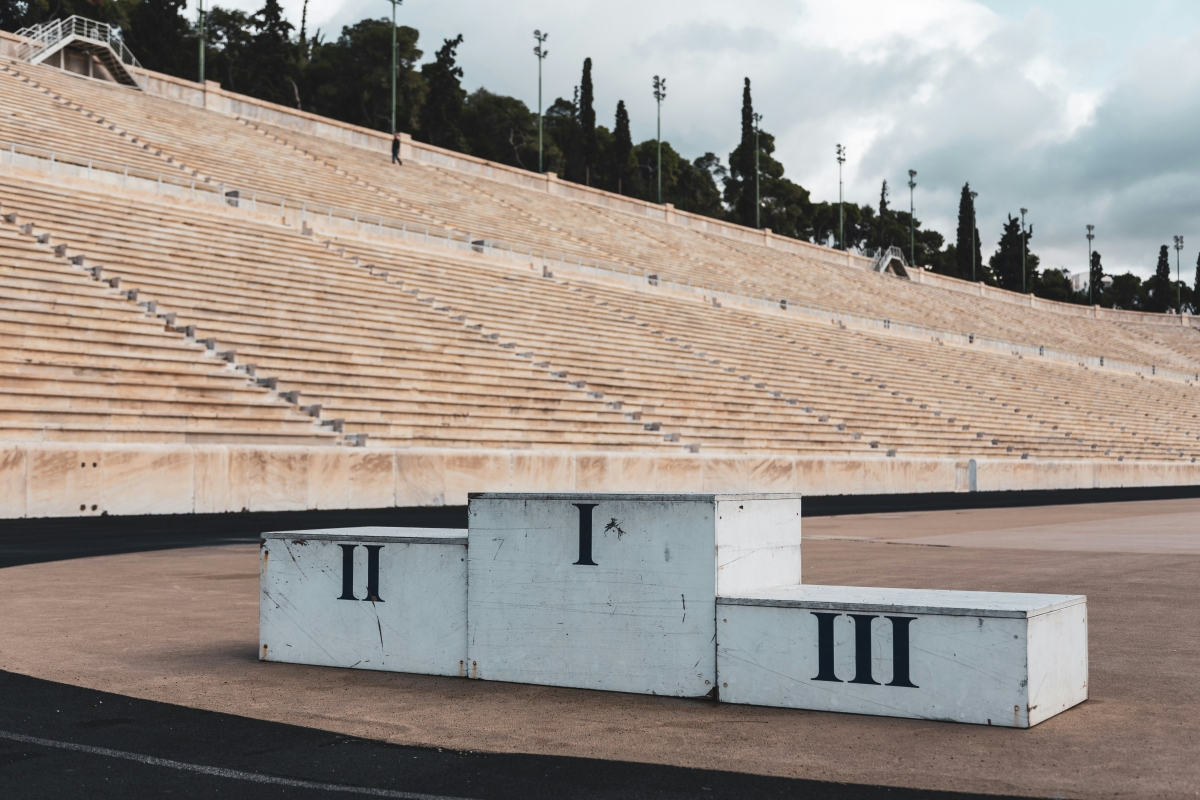In the shades of the rings – experiences of interpersonal violence in elite sports
Editor: Lisa Musculus-Schönenborn
Editorial Assistant: Elisabeth Höhne, Maren Flottmann
This article has also been translated into German and French.
How can we safeguard elite athletes from interpersonal violence in sports? An exploration of the issue and potential solutions are proposed by researchers and psychologists in the field.
For many athletes, the Olympic Games represent the pinnacle of their sporting careers. The opportunity to compete in the Olympic Games only once every four years adds to the importance of this highly awaited event. Achieving Olympic success requires a strong commitment from the athletes themselves, supported, among others, by their coaches, parents, physicians, and federations. Athletes and their teams spend years training and preparing to reach this summit. In many sporting environments, this commitment is encouraged from an early age, as young athletes often follow paths of specialisation that require a high level of dedication, personal sacrifice, and social support even before the prospect of Olympic participation becomes real. At the same time, success is never guaranteed, so athletes face uncertainty and setbacks during their whole careers. In a culture that idolises athletes and glorifies success, the pressure to excel and the competitive atmosphere are pervasive. The stakes are exceptionally high and the pursuit of victory can sometimes overshadow concerns for the well-being and health of athletes. Over the past few years, disclosures of interpersonal violence by athletes in the media have demonstrated the potential harms of highly competitive and win-oriented sporting environments [1]. Coaches using threats and abuse of power to control their athletes, authority figures engaging in sexual abuse and harassment, or instances of physical and psychological violence toward athletes [2] are alarmingly common occurrences among both elite athletes and those striving to reach that level.
The Olympic Charter [3] explicitly advocates for the promotion of safe sports and the protection of athletes from such forms of harassment, abuse, or violence. Additionally, in its consensus statement [4], the IOC identified interpersonal violence as a pressing issue that warrants immediate action and attention. To clear up the so-called “gray areas” about what constitutes interpersonal violence, precise definitions are crucial. According to the World Health Organization (WHO), interpersonal violence is defined as “the intentional use of physical force or power, threatened or actual, [...] against another person, or against a group or community, that results in or has a high risk of resulting in injury, death, psychological harm, poor development or deprivation” [5]. Four forms of interpersonal violence are generally distinguished in the context of sports [4, 6]:
 Image 2: Interpersonal Violence
Image 2: Interpersonal Violence
Many elite athletes experience interpersonal violence during their careers and experiencing interpersonal violence appears rather normalised in the elite sports world. Research indicates that around 75% of elite athletes experience at least one form of interpersonal violence during their career [7, 8]. Overall, psychological violence is the most prevalent form of interpersonal violence in the sports context, with 60-72% of athletes indicating at least one such experience [7, 8]. Psychological violence plays a special role, as it frequently co-occurs with or precedes other forms of interpersonal violence, e.g., as part of grooming processes for sexual violence [7]. Sexual violence is reported by 21-31% and physical violence by 14-25% of athletes [7, 8]. Research on neglect in sports shows that this form of interpersonal violence seems to occur frequently as well, with 37% [9] to 69% [8] of athletes affected. Neglect is frequently perpetrated against underage athletes by responsible adults such as coaches [4]. Elite athletes are at an elevated risk of experiencing neglect within the sports context due to their substantial time spent under the guardianship of coaches who bear responsibility for their well-being.
There are many prejudices about who the victims and perpetrators of interpersonal violence are. Stereotypically, male coaches are pictured as perpetrators of sexual violence, while a young and often female athlete is the victim. However, current research illustrates a differentiated view, recognising that perpetrators are not only coaches but often peer athletes who inflict interpersonal violence onto each other [8, 10]. While male coaches are more often reported as perpetrators of sexual and physical violence, the role of female coaches as perpetrators or enablers of interpersonal violence should not be overlooked. A significant number of reported cases involving multiple perpetrators and/or neglect, psychological violence, and physical violence include female perpetrators [10]. While athletes of female gender appear more susceptible to interpersonal violence [7, 8], the prevalence for male athletes is still high. Underreporting of male survivors of interpersonal violence is likely due to cultural norms [9]. A higher vulnerability also exists for athletes that identify themselves as non-heterosexual, and special consideration should be given to athletes with disabilities, as they might require particular approaches to prevention or intervention [8, 9]. Beyond sports, athletes who have experienced victimisation previously (e.g., in school or within their families) are alarmingly susceptible to experiencing further victimisation within the sports realm [9]. This raises concerns about the cumulative impact of harm across various settings. Additionally, several risk factors need to be considered specifically in the context of elite sports. Aspiring elite athletes live in a unique world, one where their lives are consumed by an intense focus on sports and success, often nested within a closed-off and selective high-performance training environment, even while balancing academic commitments in school. For instance, they might dedicate countless hours to rigorous training sessions, strict dietary regimens, and specialised coaching programs, all aimed at achieving peak performance in their chosen sport.
The boundaries between “pushing limits” and harmful practices often blur, leaving athletes vulnerable to various forms of victimisation disguised as necessary sacrifices for success. The very hierarchy that structures the elite sports world creates fertile ground for abuse, with athletes highly dependent on coaches, facilities, and federations for the realisation of their dreams. This structure does not only affect adult athletes on the road to a World Championship or the Olympic Games, it also affects all stages that might be leading to the – uncertain – career of a professional athlete, putting young athletes at risk. It is a system where power imbalances are stark, often silencing potential victims and leaving them unaware of where acceptable training ends and exploitation begins. This vulnerability is further compounded by the culture itself, where early specialisation, intense competition, long training hours, and absolute dedication to sports – traditionally associated with athletic excellence – appear to be risk factors for abuse. This potent mix of isolation, blurred lines, and inherent power dynamics demands urgent change to protect athletes both on and off the field. Lastly, but most importantly, interpersonal violence in sports is a profound issue with far-reaching consequences for victims, affecting their well-being and self-esteem, and increasing their psychological distress, the incidence of self-harm, suicidal ideation, and eating disorders [4, 11, 12, 13, 14].
Due to the high normalisation of interpersonal violence in organised sports [7, 8, 12], it is necessary to talk about the needed cultural changes. Keeping prevalence and the perpetrator groups in mind, it seems evident that the occurrence of interpersonal violence in sports is a systematic problem affecting all levels – by either being a perpetrator, being a victim, or being both. How come interpersonal violence is so pervasive? Authors suggest these main factors: the reputation of sports as inherently beneficial, the perceived necessity of interpersonal violence for performance outcomes, and the high identification with being an athlete – all within a frame of imbalanced power [7, 8, 12, 15, 16, 17, 18, 19]. Latest research also shows that the culture of how athletes are treated and treat themselves has an either positive or negative impact on performance outcomes and the (mental & physical) health of athletes [14]. Looking at the Olympic Games and the journey that leads to this summit in an athlete’s career, the question arises what measures can be initiated to address this issue. In sports practice, the clear definitions and classifications established in research are not consistently implemented. Identifying interpersonal violence becomes difficult in a culture where success is associated with harsh training and psychological abuse is accepted. Athletes may have internalised harmful norms or abusive behaviour, which further discourages them from reporting abuse because they fear reprisals or believe that enduring such treatment is a prerequisite for success [1]. When implementing preventive measures, it is essential to consider the risk factors associated with these norms.
The project “Safe Clubs”, led by Dr. Jeannine Ohlert at the German Sport University Cologne, addresses the aforementioned conditions in order to implement evidence-based measures. The project focuses on three key areas: analysis, prevention, and intervention, with five sub-projects covering these domains. Its overarching goal is to provide materials and concepts to support sports clubs across Germany in developing sustainable strategies to protect children and youth from interpersonal violence in sports settings. The project, conducted in collaboration with the German Olympic Youth Organisation and various regional sports associations, directly contributes to preventing interpersonal violence in organised sports in Germany. The five sub-projects include conducting risk analyses in selected clubs, developing and evaluating prevention workshops for athletes, coaches, parents, and officials, providing support for child protection officers in sports associations and clubs, and creating transfer products to disseminate project outcomes to sports clubs nationwide. The preventive approaches, for example, include incentives that encourage athletes to confront their personal boundaries, educate adults and coaches on how to change cultures, establish positive high-performance climates, and employ communication strategies to prevent interpersonal violence. By engaging with key stakeholders and implementing comprehensive strategies, the project aims to foster a culture of awareness, prioritising the well-being of young athletes and advocating for a high-performance culture devoid of violence in both competitive and recreational settings. In this way, a cultural shift can be initiated where almost every Olympic athlete commences their sports careers: within sports clubs as a kid with big dreams.
 Image 3: ProtectionThere are many more proposals and projects on the rise to tackle the major challenge of changing the culture within sports on several levels, coming from different federations of researchers and sports such as the Research Chair in
Safety and Integrity in Sport (SIMS), the IOC Safe Sport Unit, and Pro Safe Sport +. Hence, research is increasingly focusing on the issue of interpersonal violence and potential preventive approaches – the challenge is to translate these approaches into practice. As mentioned above, research has successfully classified four forms of interpersonal violence and established definitions of what a crossed boundary can look like [20]. In practice, however, a gray area exists in defining when a boundary has been unmistakably crossed. Besides the clear identification of boundary violations, pursuing consequences poses a challenge for practice. Rarely do consequences occur for perpetrators, and in cases where, for example, expulsion from the club or association happens, there are numerous examples of coaches being rehired in other clubs, either nationally or internationally, continuing their job (and thus, potentially perpetuating their questionable coaching philosophies). For this reason, both national and international regulations are necessary that explicitly address and challenge harmful practices within sports. Such regulations should encompass clear guidelines on acceptable coaching practices, enforce ethical standards, ensure consequences for any violations, establish mechanisms for reporting abuse, and prioritise athlete well-being. Furthermore, the
collaboration of umbrella organisations from diverse countries is urgently needed to e.g., prevent convicted coaches from obtaining a new job in other countries. By implementing such regulations, the sports community can strive to create an environment where
power is wielded responsibly, the well-being of athletes is prioritised over harmful coaching practices, and a culture devoid of violence is advocated for.
Image 3: ProtectionThere are many more proposals and projects on the rise to tackle the major challenge of changing the culture within sports on several levels, coming from different federations of researchers and sports such as the Research Chair in
Safety and Integrity in Sport (SIMS), the IOC Safe Sport Unit, and Pro Safe Sport +. Hence, research is increasingly focusing on the issue of interpersonal violence and potential preventive approaches – the challenge is to translate these approaches into practice. As mentioned above, research has successfully classified four forms of interpersonal violence and established definitions of what a crossed boundary can look like [20]. In practice, however, a gray area exists in defining when a boundary has been unmistakably crossed. Besides the clear identification of boundary violations, pursuing consequences poses a challenge for practice. Rarely do consequences occur for perpetrators, and in cases where, for example, expulsion from the club or association happens, there are numerous examples of coaches being rehired in other clubs, either nationally or internationally, continuing their job (and thus, potentially perpetuating their questionable coaching philosophies). For this reason, both national and international regulations are necessary that explicitly address and challenge harmful practices within sports. Such regulations should encompass clear guidelines on acceptable coaching practices, enforce ethical standards, ensure consequences for any violations, establish mechanisms for reporting abuse, and prioritise athlete well-being. Furthermore, the
collaboration of umbrella organisations from diverse countries is urgently needed to e.g., prevent convicted coaches from obtaining a new job in other countries. By implementing such regulations, the sports community can strive to create an environment where
power is wielded responsibly, the well-being of athletes is prioritised over harmful coaching practices, and a culture devoid of violence is advocated for.
In addition to clear regulations on handling reported incidents, it is crucial to listen to, support, and protect victimised athletes. This calls for (inter)national support services that believe reports unconditionally and provide a protected space for consultation. Studies indicate that disclosing abuse within the sports structure is exceptionally challenging [9], underscoring the importance of external, confidential support services. These expert services can also play a crucial role in empowering athletes to come forward, seek assistance, and break the cycle of silence perpetuated by the sports culture. Moreover, these support services should honour the victims’ wishes and perspectives during inquiry processes. Affected athletes seek remedy, which is, however, highly individual and fundamentally entails boundary restoration or a clear acknowledgment that something wrong has occurred. In general, by expanding and promoting accessible support services for both victims and witnesses, athletes can be assured of reliable resources when facing instances of interpersonal violence and obtain the remedy they require.
In summary, addressing the issue of
power abuse and interpersonal violence in sports requires a comprehensive approach, encompassing the establishment of preventive measures and international regulations along with expert support services. As highlighted in the preceding statements, the high prevalence of violence in sports is undeniable, as a
significant majority of elite athletes have experienced or will encounter some form of interpersonal violence during their careers. This emphasises the need for collective awareness within the sports community to actively foster a high-performance sports culture that is characterised by responsible
power dynamics, prioritising athlete well-being, and opposing abusive practices. The ultimate objective is to aim for a culture that facilitates outstanding athletic achievements while safeguarding athletes from any form of harm; in essence: implementing the norms that are stated in the Olympic Charter [3].
Bibliography
[1] Roberts, V., Sojo, V., & Grant, F. (2020). Organisational
factors and non-accidental violence in sport: A systematic review. Sport Management Review, 23(1), 8–27. https://doi.org/10.1016/j.smr.2019.03.001
[2] Hall, M. (2023, January 27). ‘Tip of the iceberg’: why abuse in Canadian sport is worse than it seems. The Guardian. https://www.theguardian.com/sport/2023/jan/27/abuse-canada-sport-inquiry...
[3] International Olympic Committee (2023). Olympic charter. International Olympic Committee. https://stillmed.olympics.com/media/Document%20Library/OlympicOrg/Genera...
[4] Mountjoy, M., Brackenridge, C., Arrington, M., Blauwet, C., Carska-Sheppard, A., Fasting, K., Kirby, S., Leahy, T., Marks, S., Martin, K., Starr, K., Tiivas, A., & Budgett, R. (2016). International Olympic Committee consensus statement: Harassment and abuse (non-accidental violence) in sport. British Journal of Sports Medicine, 50(17), 1019–1029. https://doi.org/10.1136/bjsports-2016-096121
[5] Krug, E. G., Mercy, J. A., Dahlberg, L. L., & Zwi, A. B. (2002). The world report on violence and health. The Lancet, 360(9339), 1083–1088. https://doi.org/10.1016/S0140-6736(02)11133-0
[6] Fortier, K., Parent, S., & Lessard, G. (2020). Child maltreatment in sport: Smashing the wall of silence: A narrative review of physical, sexual, psychological abuses and neglect. British Journal of Sports Medicine, 54(1), 4–7. https://doi.org/10.1136/bjsports-2018-100224
[7] Ohlert, J., Vertommen, T., Rulofs, B., Rau, T., & Allroggen, M. (2021). Elite athletes’ experiences of interpersonal violence in organized sport in Germany, the Netherlands, and Belgium. European Journal of Sport Science, 21(4), 604–613. https://doi.org/10.1080/17461391.2020.1781266
[8] Willson, E., Kerr, G., Stirling, A., & Buono, S. (2021). Prevalence of maltreatment among Canadian national team athletes. Journal of Interpersonal Violence, 37(21-22), NP19857-NP19879. https://doi.org/10.1177/08862605211045096
[9] Hartill, M., Rulofs, B., Allroggen, M., Demarbaix, S., Diketmüller, R., Lang, M., Martin, M., Nanu, I., Sage, D., Stativa, E., Kampen, J., & Vertommen, T. (2023). Prevalence of interpersonal violence against children in sport in six European countries. Child Abuse & Neglect, 146, 106513. https://doi.org/10.1016/j.chiabu.2023.106513
[10] Vertommen, T., Kampen, J., Schipper-van Veldhoven, N., Wouters, K., Uzieblo, K., & Van Den Eede, F. (2017). Profiling perpetrators of interpersonal violence against children in sport based on a victim survey. Child Abuse & Neglect, 63, 172–182. https://doi.org/10.1016/j.chiabu.2016.11.029
[11] Parent, S., Vaillancourt-Morel, M.-P., & Gillard, A. (2021). Interpersonal violence (IV) in sport and mental health outcomes in teenagers. Journal of Sport and Social Issues, 46(4), 323–337. https://doi.org/10.1177/01937235211043652
[12] Rulofs, B., Wahnschaffe-Waldhoff, K., Neeten, M., & Söllinger, A. (2022). Sexualisierte Gewalt und sexueller Kindesmissbrauch im Kontext des Sports [Sexualized violence and child sexual abuse in the context of sport]. Unabhängige Kommission zur Aufarbeitung sexuellen Kindesmissbrauchs. https://www.aufarbeitungskommission.de/wp-content/uploads/Sexueller-Kind...
[13] Timpka, T., Spreco, A., Dahlstrom, O., Jacobsson, J., Kowalski, J., Bargoria, V., Mountjoy, M., & Svedin, C. G. (2021). Suicidal thoughts (ideation) among elite athletics (track and
field) athletes: associations with sports participation, psychological resourcefulness and having been a victim of sexual and/or physical abuse. British Journal of Sports Medicine, 55(4), 198–205. https://doi.org/10.1136/bjsports-2019-101386
[14] Willson, E., Buono, S., Kerr, G., & Stirling, A. (2023). Maltreatment experiences and mental health indicators among elite athletes. Psychology of Sport and Exercise, 69, 102493. https://doi.org/10.1016/j.psychsport.2023.102493
[15] Carless, D., & Douglas, K. (2013). “In the boat” but “selling myself short”: Stories, narratives, and identity development in elite sport. The Sport Psychologist, 27, 27–39. https://doi.org/10.1123/tsp.27.1.27
[16] Lochbaum, M., Cooper, S., & Limp, S. (2022). The athletic identity measurement scale: A systematic review with
meta-analysis from 1993 to 2021. European Journal of Investigation in Health, Psychology and Education, 12, 1391–1414. https://doi.org/10.3390/ejihpe12090097
[17] Rulofs, B. (2016). “Safe Sport”: Schutz von Kindern und Jugendlichen im organisierten Sport in Deutschland – Erste Ergebnisse des Forschungsprojektes zur Analyse von Häufigkeiten, Formen, Präventions- und Interventionsmaßnahmen bei sexualisierter Gewalt [“Safe sport”: Protection of children and young people in organized sport in Germany – First results of the research project to analyse the frequency, forms, prevention and
intervention measures for sexualized violence]. Deutsche Sporthochschule Köln, Institut für Soziologie und Genderforschung.
Images
Image 1: Podium: Schmetz, F. (2020). Maison en béton blanc et brun [Photograph]. Unsplash. https://unsplash.com/fr/photos/maison-en-beton-blanc-et-brun-fbCtFV3FkfE
Image 2: self-created, property of the authors
Image 3: The girl with the helmet: Chekhomova, C. (2023). Girl in Helmet on White Background [Photograph]. Pexels. https://www.pexels.com/photo/girl-in-helmet-on-white-background-17602026/





